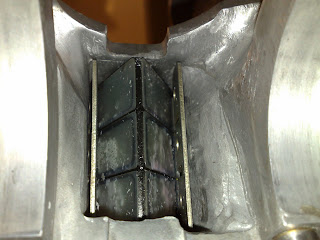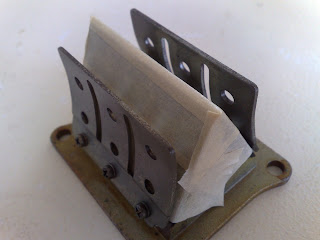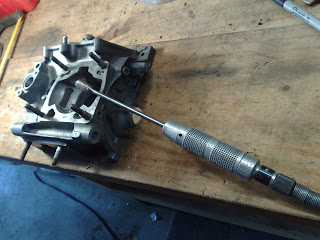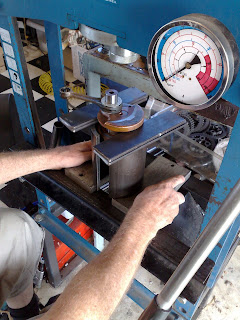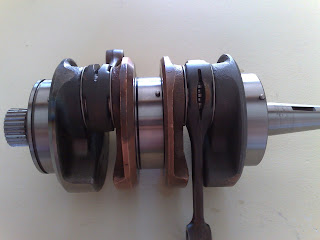This morning I put most of my engine bits in a big box and went over to Tim's.
Used the paint stripper heat gun to warm up the main crankcase and Tim dropped in the bearings.
He also put in the clutch actuator bearings and seal. Gear change shaft bearing and seal.
Heated up the cassette gearbox plate and plonked in those bearings.
Assembled the gear shafts with their bearings.
########################################################
Bearing listing update 2018/05/05.

I have ordered a set of bearings and seals for the gearbox.
I thought I might as well post it up here for reference.
This is for MC21 and MC18 R5/6k. Possibly other models as well, but I am not sure about that.
Format in mm is: (ID-OD-width)
Bearings
1 x 6203-RS (17-40-12) Counter Shaft LH $5.43
1 x 6204-2RS (20-47-14) Output shaft RH $7.53
1 x 6205-2RS (25-52-15) Counter shaft RH $7.99
1 x 6305-RS (25-62-17) Output shaft LH $10.81
1 x NTN 7B HK 1412 (14-20-12) internal needle roller - Gear change shaft $7.82
Seals
1 x 12-19-5 Clutch actuator $3.45
1 x 14-24-6 Gear change shaft $3.80
1 x 25-47-7 Output shaft LH $5.29
2 x 9-18-7 Power valve shaft $3.57 each
I have left out the 2 small internal needle rollers that are up in the clutch actuator "tunnel".
They are 12-16-10 and 10-14-10
Also I have left out the selector drum bearing. Not too sure of its exact dimensions.
Prices are in $NZ and include 15% GST (Tax)
Total cost is NZ$59.25
########################################################
A special note about the Bearing that goes on the output shaft where the front sprocket goes for the final drive chain.
There is a transmission oil pump on the RH side of the engine. It pumps oil through a tricky little pathway in the crankcase and that oil comes out on the LH side of the front sprocket bearing.
In order for that oil to make its way back into the engine via specially located holes in the transmission shafts it is necessary to have the outer bearing seals installed on the LH transmission shaft bearings but not on the inside of the bearings.
So make sure that the inner seals are removed and the outer seals are left in place on both LH gear shaft bearings before installing.
For a lot of detail on this see this post:
https://www.tapatalk.com/groups/nsr250/transmission-oil-pump-pathway-t589.html#p3332
##########################################################
Then I pulled out an old barrel and asked Tim to show me how best to use his comprehensive range of porting tools to smooth off the sharp lipped edges on the barrel ports.
I had a bit of a practice on the old barrel before continuing on with my good barrels.
This is a pretty minor tweak but I just wanted to maximise flow.
It was fun to do it once and was quite satisfying. I took my time, and if anything probably left very slight "lippage" rather than grind off too much. After the lip grinding, I went around all the edges with a polishing head and was careful to make the edges all smooth and non ring-grabby. Spent about 3 hours on the dremmel which is pretty slow going, but I was being overly cautious on purpose.
I also ate into the bottom of the transfer ports bridge wall. Just rounding it off. Apparently this is "The Go". I didn't argue or question it, I just did it under blind faith. Although, I have to admit that I had seen it done on other two stroke barrels before.
So now I just need to "Dev Con" in a 6mm plate (12.5cc's) of aluminium against the left most reed block wall on the crankcase to get the two primary compression volumes equal and then I can assemble the engine in its entirety.
I am hoping that these little porting tweaks will present as real horsepower in the long term, but even if that is not the case, I have been happy to play about and try to get things reasonably optimal anyway. It's fun.
Arrived Tim's approx 10:30. Left Tim's approx 7:30.



